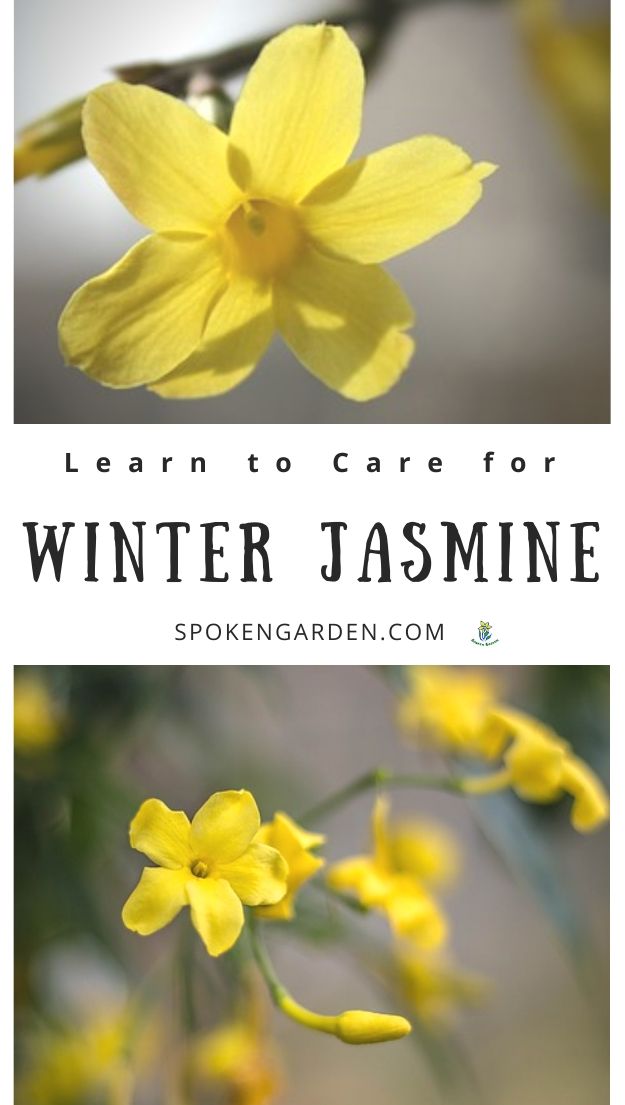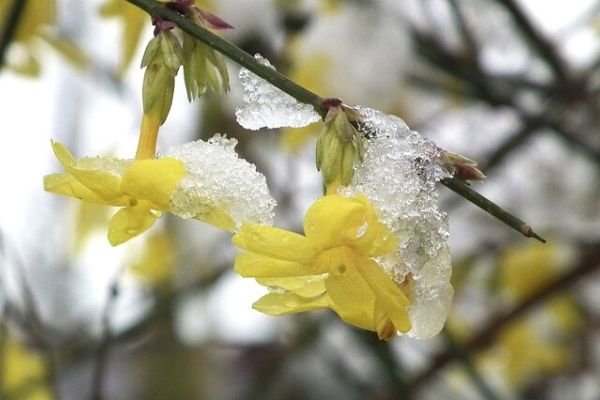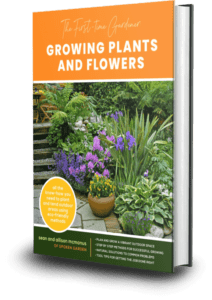Learn all about Winter Jasmine in this gardener’s guide of these beautiful perennials, including plant care, companion plants, and more.
Winter Jasmine is a curious find in any garden. Whether spreading low over large areas or forming mounds resembling shrubs, its unique growth and profuse yellow flowers (that bloom in mid-winter to early spring) will brighten and accentuate any garden they happen to grace.
A member of the Olive family (Oleaceae), it has seasonal potential and interest along with its year-round texture of deciduous stems and unique growth.
In this winter jasmine plant profile, you’ll learn about the characteristics of this spreading vine type of plant as well as basic plant care and companion plants for your landscape.
If you’re already lucky enough to grow this particular deciduous perennial in your garden but you are unsure how to best care for it, this post will teach you the skills you’ll need. Or, if you are new to gardening and want to add this type of vine (or others similar to it) to your landscape but you’re scared you might kill them with your black thumb, don’t worry.
This post will give you the confidence you need to grow and care for them on your own.
Quick Plant Care Facts
| Sun Exposure | Thrives in full sun or light shade. |
| Water Needs | Needs moderate to regular watering. |
| Soil Needs | Well draining soil, but not highly fertile. |
| Cold-Hardiness Zones | USDA hardiness zones 6 to 9. |
| Bloom Time | From winter into early spring. |
| Flower Colors | Bright yellow and can grow up to 1 inch size. |
| Mature Height/Width | Grows to 4 ft tall if unsupported and 7 ft wide. If grown on a trellis or wall it can grow up to 15 or so feet high. |
| Plant Spacing | For dense plantings, space plants 6-7 feet a part. For more open areas and room to grow/less need for any weed control, spacing can be more of 8 feet or larger a part from each other or other plants. |
Winter Jasmine: Why You Might Want It In Your Garden
If you are looking for some pre-spring bling of flower color in your garden, then winter jasmine, Jasminum nudiflorum, should definitely be on your list to add to your garden.
These fun and amazing plants are just what any general garden needs to give it new life and provide bright, pops of color before spring officially begins. Oh, and unlike other jasmine plants, this plant has no fragrance.
Even without a sweet fragrance, this plant can kick your spring off to a great start with bright yellow flowers.
There aren’t any cultivars or different varieties being sold out there right now, but winter jasmine does come in variegated leaf forms, so keep an eye out for those for any of you out there looking to stand out from the rest of the crowd.
A fun note about winter jasmine is that it can self-root when stems lay on or get covered below the ground, so you can then cut away and have new plants to spread to other parts of your garden or give to your neighbor or garden friends.
Read on to learn more about this awesome shrub in the winter garden.
Jasmine: History and Uses
As you begin your journey to understand more about jasmine plant care, a good place to start is to first learn about their family group, their history, and their uses.
Oleaceae Family
Winter jasmine is in the Oleaceae Family. Also known as the olive family, this family group has over 200 species of fragrant-flowered shrubs and vines.
The olive family features some of the most popular flowers in the world known for their aromatic scents.
Olive family members are valued for a range of uses, including:
- Perfumes
- Cooking oils
- Ornamental gardens
- Herbal teas
- Other medicinal uses
Other members of the Oleaceae family include olive trees, ash, privet, forsythia, lilac, and many more.
History of Jasmine (in Brief)
Winter jasmine, or Jasminum nudiflorum, is native to China.
The name “Jasmine” is Latin for the Persian name Yasmin or Yasamin. In addition, the name “nudiflorum” refers to “naked flower.”
This plant was first discovered and collected in China by Robert Fortune.
Winter jasmine is best known as an ornamental winter-bloomer in gardens around the world. Some great uses for winter jasmine are mounding shrub-forms or as a thick ground cover.
People also enjoy winter jasmine draped over retaining walls or climbing up arbors and trellises.
One notable award for this plant was given by the Royal Horticultural Society with its Award of Garden Merit.
Today, winter jasmine is a great choice for winter gardens due to its yellow flowers, tolerance for cooler weather, and evergreen foliage the remainder of the year.
Winter Jasmine Care
Now that you’ve learned a bit of background information about this winter-blooming perennial, keep scrolling to learn more about planting steps, companion plants, and differences between winter jasmine and forsythia.
What is the Difference Between Winter Jasmine and Forsythia
Forsythia and winter jasmine are commonly mistaken for one another. Rightfully so, they both have yellow flowers and have similar blooming times.
However, a big difference is that winter jasmine blooms during the winter and forsythia blooms in the early spring. Therefore, winter jasmine will bloom earlier than forsythia.
One of the biggest differences between these two plants is that Jasminum nudiflorum is a vining shrub with trailing branches. Forsythia is an upright shrub that has a fountain-growth form which then spreads out to the sides.
Another important way to tell them apart is winter jasmine has leaves that are trifoliate. Its leaves are made up of three “leaflets,” meaning three small leaves make up the one small leaf. Forsythia’s leaf shape is a round, pointy-tipped leaf. (Other species of jasmine have different leaf structures).
A fun fact is that both plants flower before they develop or grow their new leaves for the season.
When Should I Plant Winter Jasmine?
Ideally, you would want to plant winter jasmine in the spring if you want to have beautiful flowers bloom the following winter season.
If flowers are not your concern, then plant it in the fall.
Perfectly suited for cooler-temperature climates, Jasminum nudiflorum fills in and spreads around adding year-round interest to your garden.
It can also help with weed control by smothering out unwelcome plants which is a great bonus.
Winter Jasmine Companion Plants
This type of jasmine blooms in the winter which is a wonderful benefit to any garden, especially if you like vines and other types of vertical-growing plants.
In the winter season, you will be a bit more limited to foliage or other winter bloomers that grow in similar conditions.
You really cannot go wrong with a companion for your Jasminum nudiflorum. It simply boils down to your individual preference, color choice, and sunlight needs.
Companion plants to consider:
- Clematis
- Lantana
- Rose
- Forsythia
- Rhododendrons
- English Laurel
Winter Jasmine Conclusion
As you’ve read above, this species of jasmine will enhance your winter landscape in so many ways. With its beautiful yellow blooms and trailing vines, you really cannot go wrong.
If you’re looking to add an interesting plant for a groundcover or on a slope, look no further than the color and garden interest of Jasminum nudiflorum.
Now we want to hear from you!
What other questions do you have about winter jasmine that we didn’t answer above? Let us know by leaving a quick comment below. Thanks!
Want to learn about other plants in your garden? Check out some of our previous plant profiles:
- Daffodils: A Gardener’s Guide and Plant Profile
- Christmas Rose (Helleborus niger): A Gardener’s Guide and Plant Profile
- Primroses: A Gardener’s Guide and Plant Profile
- Tulips: A Gardener’s Guide and Plant Profile
- Grape Hyacinth: A Gardener’s Guide and Plant Profile
- Winter Pansies: A Gardener’s Guide and Plant Profile
See you in the garden!
~ Sean and Allison
P.S. Find us on Pinterest, Twitter, Facebook, and Instagram so you don’t miss a thing!
Jasmine References:
- RHS: Jasminum nudiflorum
- Oregon State University: Landscape Plants
- North Carolina Extension Gardener: Jasmine nudiflorum
Spokengarden.com is a participant in the Amazon Services LLC Associates Program, an affiliate advertising program designed to provide a means for sites to earn advertising fees by advertising and linking to Amazon.com

Learn all about Winter Jasmine in this gardener’s guide of these beautiful perennials, including plant care, companion plants, and more.



